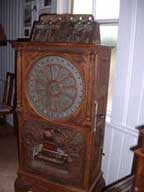Museum

Located in beautiful and historic Bruce Mines, the Bruce Mines Museum is a must see for anyone travelling in the area. The building itself has a fascinating history. Built in 1894 as a Presbyterian Church, the "Church on the Rock" was used for services until 1917 when the congregation outgrew the church and united with the Methodist
congregation, whose church could accommodate both groups.
In the same year, a fire swept through the town and the local postmaster, whose building had been destroyed, moved the post office into the vacant church building. The building was used as a scout and church hall for many years until 1945 when another fire destroyed the Bruce Mines Public School.
The building housed grades 9 - 12 for two years until grades 11 and 12 were moved to the old jail building and finally in December of 1948 the school moved into a new building. The building stood empty until the Town of Bruce Mines purchased it in 1950 when it was used as a public library and as a storage house for local artefacts. The museum officially opened in 1961 and in 1973 the library moved to the Bruce Mines Central School.
Come and visit us!
OPEN ALL SUMMER (click for details), beginning July 1st.
Tuesdays through Saturdays from 10:00 a.m. - 4:00 p.m
Outside regular hours by appointment: 705-206-0759 or 705-783-1983
The Bruce Mines Museum is located at 9227 Highway 17 East, only 40 minutes from Sault Ste. Marie.
Contact us at:
Bruce Mines Museum
c/o Bruce Mines Historical Society
Bruce Mines, ON
Canada P0R 1C0
Email: [email protected] and [email protected]
Our Star Attractions!
1876 SLOT MACHINE
This slot machine/music box is one of only two such machines made by the Gaille Novelty Co. in Windsor, Ontario. It's mate rests in a museum in Chicago.
Wooden coins were placed in the slots at the top of the machine and the handle was pulled, spinning the wheel. Music, played by the metal drum at the bottom, sounded for the winners.
This slot machine resided a hotel in Rydal Bank until the hotel closed down. The machine was then stored in a barn until it was discovered years later under a stack of hay and brought to the Bruce Mines Museum.

Front of Slot Machine

Rear of Slot Machine
YAKABOO CANOE
In 1911 Fredric Fenger built the world's only Yakaboo sailing canoe. He sailed it from Grenada throughout the Caribbean Islands, finishing his trip at the Virgin Islands.
After returning from his adventures, Fenger wrote a book called "Alone in the Caribbean".
The name Yakaboo is a word meaning "goodbye", used when Ellice Islanders drop something overboard. The Yakaboo is a covered canoe with a drop keel that can be
slid fore and aft to help maintain a straight course. This is necessary because the boat does not have a rudder and instead steering relies entirely on the set of the sails and the position of the keel.
Fenger gave the Yakaboo to his friend Dr. Blatchford of Kensington Point. The canoe was later acquired by Mr. Barrett Scudder from Campement D'Ours Island, who donated the canoe to the Bruce Mines Museum.
Click here for more information on the Yakaboo Canoe

The Yakaboo Canoe
VICTORIAN DOLLS HOUSE
This doll house was brought from England to Canada by Lord Percy Douglas, the 9th Marquess of Queensbury. The Douglas family came to Bruce Mines about 1896
when Lord Percy assumed management of the mines. The mines did not prosper at this time and the family moved back to England a few years later.
Little is known about Dorothy, the original owner of the doll house, but when she returned to England, she left the doll house to her best friend, a little girl in the Prout family. The Prouts later donated the doll house to the Bruce Mines museum.
The doll house is quite remarkable for its workmanship and detail. Actual candles in the miniature candlestick holders, Afghan fur on the dogs, tiny print on the newspaper and porcelain dolls all add to the charm of this lovely piece.


A view of two of the Rooms in the Dolls House

